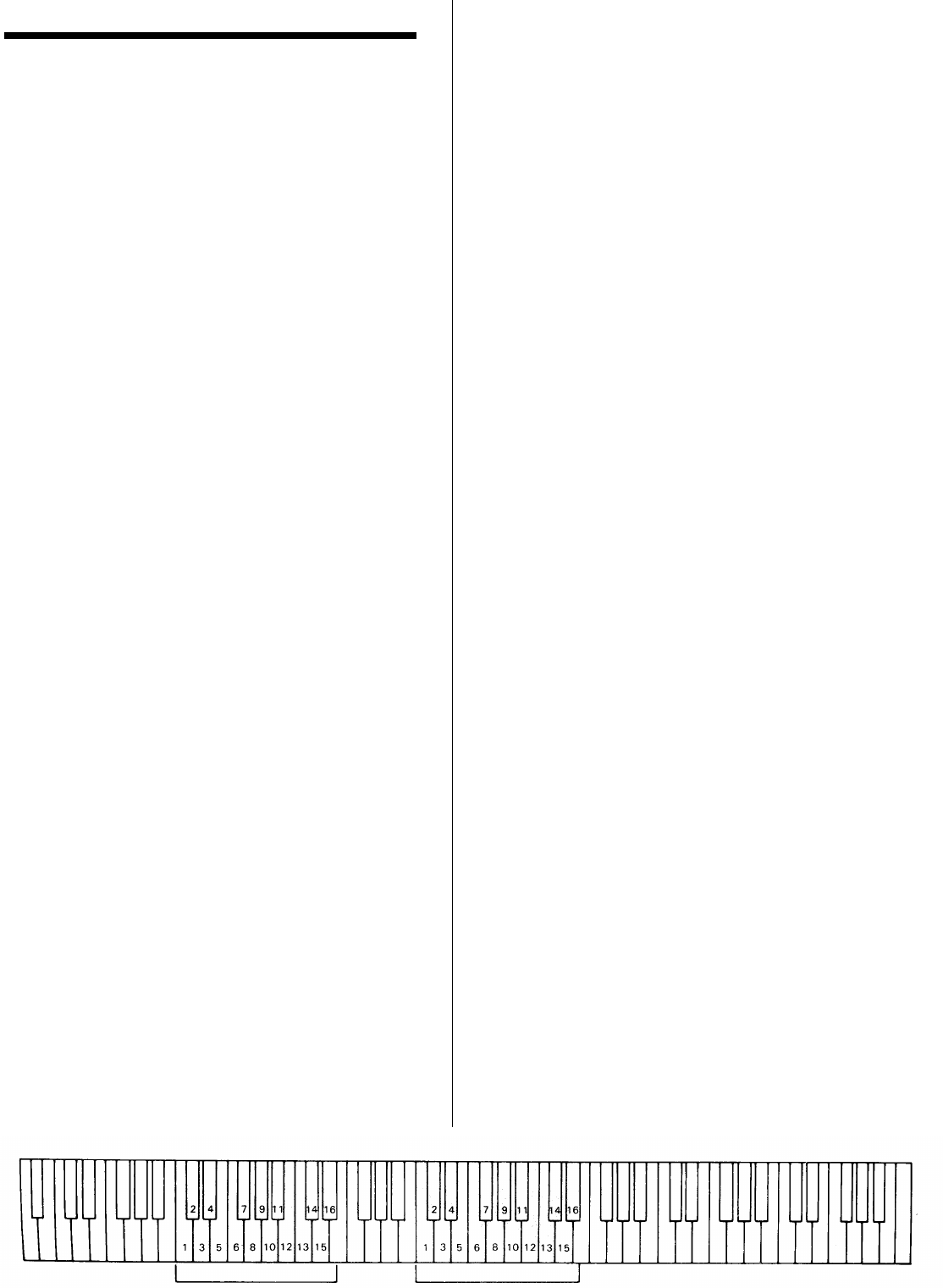
8
Control Change Numbers
Control Change data representing Soft/Sostenuto and
Damper pedal operations is transmitted by the PDP-300
whenever one of these pedals is used. If the receiving de-
vice is a tone generator or another keyboard, it will re-
spond in the same way as the PDP-300’s internal tone
generator when one of the pedals is used. The PDP-300
also receives and responds to the appropriate control
change data. See “Control Change ON/OFF” on page 9
for information on turning control change number recep-
tion and transmission ON or OFF.
MIDI Transmit & Receive Channel
Selection
The MIDI system allows transmission and reception of
MIDI data on 16 different channels. Multiple channels
have been implemented to allow selective control of cer-
tain instruments or devices connected in series. For ex-
ample, a single MIDI sequencer could be used to “play”
two different instruments or tone generators. One of the
instruments or tone generators could be set to receive
only on channel 1, while the other is set to receive on
channel 2. In this situation the first instrument or tone
generator will respond only to channel-1 information
transmitted by the sequencer, while the second instru-
ment or tone generator will respond only to channel-2 in-
formation. This allows the sequencer to “play” two com-
pletely different parts on the receiving instruments or
tone generators.
In any MIDI control setup, the MIDI channels of the
transmitting and receiving equipment must be matched
for proper data transfer. An “OMNI” receive mode is
also available, which allows reception on all 16 MIDI
channels. In the OMNI mode it is not necessary to match
the receive channel of the receiving device to the the
transmit channel of the transmitting device (except when
receiving mode messages).
Setting the MIDI Channels
1. Press and hold the [MIDI/TRANSPOSE] button.
2. Press the key on the keyboard corresponding to the
desired MIDI transmit or receive channel.*
3. Release the [MIDI/TRANSPOSE] button.
* Keys C1 through D 2 on the keyboard are used to set the
MIDI transmit channel, and keys C3 through D
#
4 are used to
turn the OMNI mode OFF and set the MIDI receive channel as
shown in the illustration below. The E4 key sets the OMNI
receive mode and basic receive channel 1.
Note: When the power is initially turned ON, MIDI receive is set
to the OMNI mode and the transmit channel is set to 1.
MIDI FUNCTIONS
A Brief Introduction to MIDI
MIDI, the Musical Instrument Digital Interface, is a
world-standard communication interface that allows
MIDI-compatible musical instruments and equipment to
share musical information and control one another. This
makes it possible to create “systems” of MIDI instru-
ments and equipment that offer far greater versatility and
control than is available with isolated instruments. For
example, most MIDI keyboards transmit note and veloc-
ity (touch response) information via the MIDI OUT con-
nector whenever a note is played on the keyboard. If the
MIDI OUT connector is connected to the MIDI IN con-
nector of a second keyboard (synthesizer, etc.) or a tone
generator, the second keyboard or tone generator will re-
spond precisely to notes played on the original transmit-
ting keyboard. The result is that you can effectively play
two instruments at once, providing thick multi-instru-
ment sounds.
This same type of musical information transfer is used
for MIDI sequence recording. A sequencer can be used
to “record” MIDI data received from PDP-300, for ex-
ample. When the recorded data is played back, the PDP-
300 automatically “plays” the recorded performance in
precise detail.
Note: Always use a high-quality MIDI cable to connect MIDI
OUT to MIDI IN terminals. Never use MIDI cables longer
than about 15 meters, since cables longer than this can
pick up noise which can cause data errors.
MIDI “Messages” Transmitted &
Received by the PDP-300
The MIDI information (messages) transmitted and re-
ceived by the PDP-300 is as follows:
Note and Velocity Data
This information tells the receiving keyboard or tone
generator to play a certain note (specified by the MIDI
note number) at a certain dynamic level (specified by the
MIDI velocity value). Note and velocity data is transmit-
ted by the PDP-300 whenever a key is pressed, and the
PDP-300’s internal AWM tone generator will “play” the
corresponding note(s) whenever note and velocity data is
received from an external MIDI device.
Program Change Numbers
The PDP-300 transmits a MIDI program number be-
tween 0 and 5 when one of its voice selectors is pressed.
This normally causes the correspondingly numbered
voice or program to be selected on a receiving MIDI de-
vice. The PDP-300 will respond in the same way, auto-
matically selecting the appropriate voice when a MIDI
program change number is received. See “Program
Change ON/OFF” on page 9 for information on turning
program change number reception and transmission ON
or OFF.
For setting the receive channel. (C3 ~ D#
4)
For setting the transmit channel. (C1 ~ D#2)


















